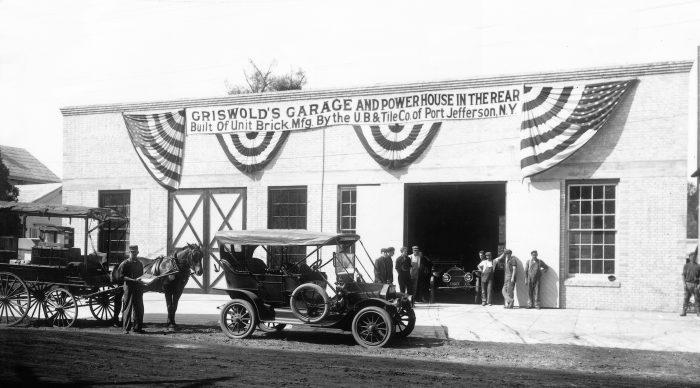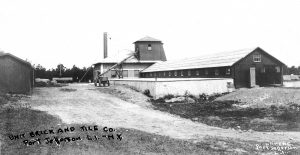Like a shooting star: The Unit Brick and Tile Company

Incorporated in 1910, the Unit Brick and Tile Company was located on Hallock Avenue, just south of the LIRR tracks, in today’s Port Jefferson Station.
Employing 20 workers on an 11-acre site, the plant manufactured standard brick, roofing and flooring tile, and hollow block, but was best known for producing Unit brick.
Made from sand, gravel and cement, Unit brick had a distinctive U-shape and could be finished in a variety of shades thus eliminating the need for interior painting.
According to its boosters, Unit brick was 33-66% cheaper than common brick, impervious to dampness and as strong as conventional building materials.
Fanning’s Garage, West Broadway, Port Jefferson, and Chris Henningsen’s residence, Hallock Avenue, Port Jefferson Station, were among the first buildings in the area to be constructed of Unit brick. It was later used in building projects in Belle Terre, St. James, Patchogue, Old Field, Smithtown and Wading River.
Unit brick was also shipped by schooner, such as the Emma Southard, to destinations in New York as varied as Hastings-on-Hudson, Staten Island and Lloyd Neck.
To popularize Unit brick, the company exhibited its signature product in a store on Port Jefferson’s East Main Street. The showroom opened in August 1911 during Old Home Week, an event that brought thousands of visitors to the village.

In addition, the corporation was promoted by members of the Port Jefferson Business Men’s Association, especially Jacob S. Dreyer, publisher of the Port Jefferson Times, and advertised in the Brooklyn Daily Eagle and Port Jefferson Echo. In August 1912, newspapermen from the Long Island Press Association toured Unit Brick’s factory.
The company received glowing testimonials from customers such as Belle Terre’s William Wadsworth who wrote in 1913 that Unit brick was “the best all-around building material on the market.”
Prominent Port Jefferson lawyer Thomas J. Ritch, Jr. and physician Luther H. Chambers, both of whom served on Unit Brick’s Board of Directors, lent their respected names to the venture.
Unit Brick enjoyed a meteoric rise marked by encouraging sales and good publicity, but much like a shooting star soon burned out, several factors contributing to the corporation’s early demise.
Unit Brick faced competition from another local startup, the Dyett Sand-Lime Brick Company on the west side of Port Jefferson Harbor, as well as from the established Port Jefferson Cement Block Company on High Street.
Court proceedings followed allegations that Unit brick was an inferior product and being delivered “damp.”
The company expanded too rapidly, opening subsidiaries in Connecticut and Rhode Island, where demand for its goods was not as strong as anticipated.
Perhaps most important, the building trades had a long tradition of using red clay brick and simply balked at trying a new product.
After Unit Brick dissolved in 1917, a receiver was appointed. The corporation’s machinery and equipment were sold at public auction in 1918 and bought by the Port Jefferson Junk Company for $2,150. In 1920, Unit Brick’s former property in Port Jefferson Station was purchased by the LIRR which built a yard for its locomotives and cars on the acreage.
Kenneth Brady has served as the Port Jefferson Village Historian and president of the Port Jefferson Conservancy, as well as on the boards of the Suffolk County Historical Society, Greater Port Jefferson Arts Council and Port Jefferson Historical Society. He is a longtime resident of Port Jefferson.






